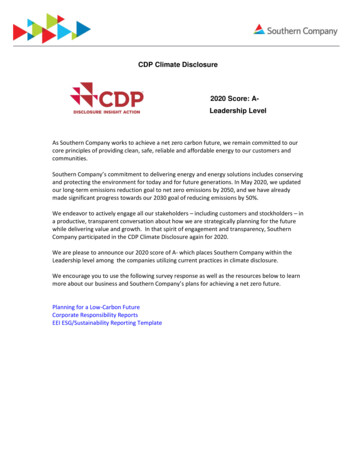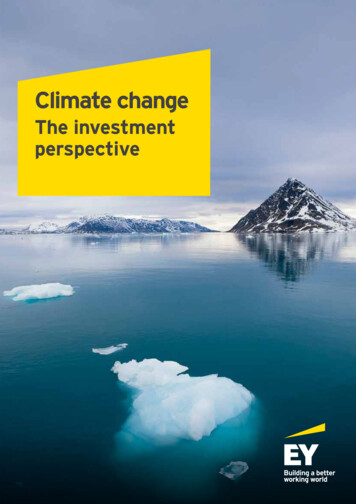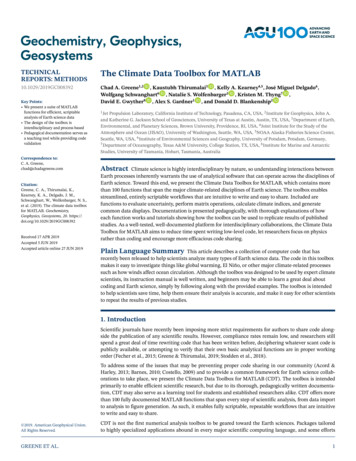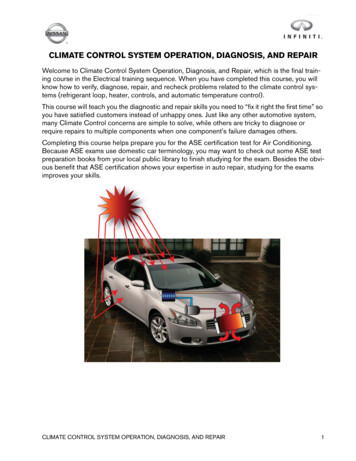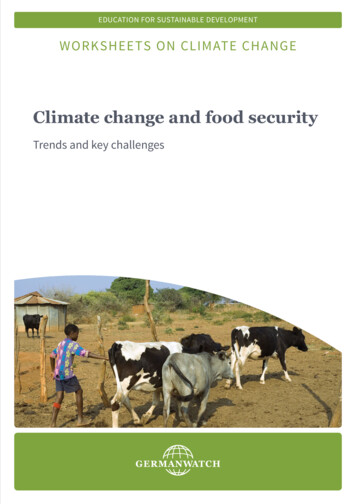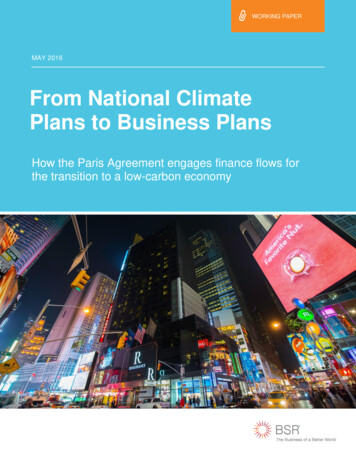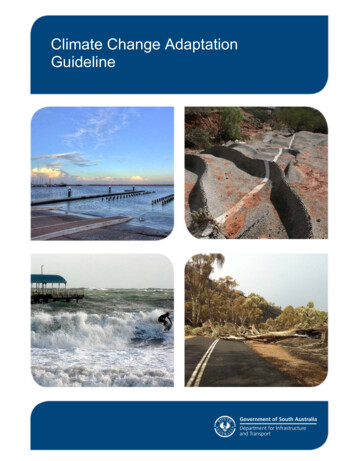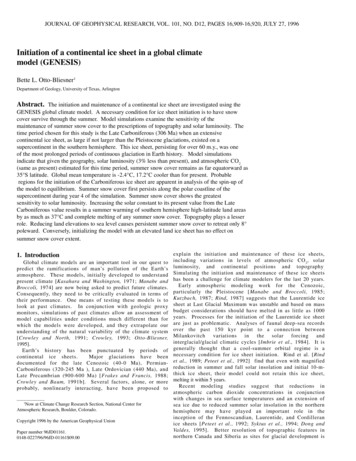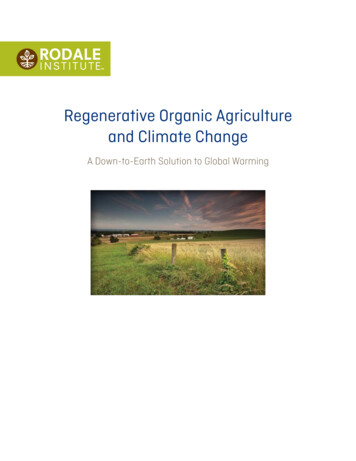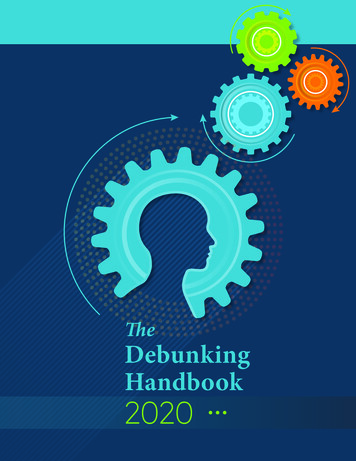
Transcription
TheDebunkingHandbook2020
AuthorsStephan LewandowskyUniversity of Bristol andUniversity of Western Australiacogsciwa.comDavid N. RappSchool of Education and Social Policy & Departmentof Psychology, Northwestern Universityrapplab.sesp.northwestern.eduJohn CookGeorge Mason Universityclimatechangecommunication.orgJason ReiflerUniversity of Exeterjasonreifler.comUllrich EckerUniversity of Western Australiaemc-lab.orgDolores AlbarracínUniversity of Illinois at Urbana chelle A. AmazeenBoston yiota KendeouDepartment of Educational Psychology,University of Minnesotacehd.umn.edu/edpsych/people/kend0040/Doug LombardiUniversity of Marylandsciencelearning.netEryn J. NewmanResearch School of Psychology,The Australian National Universityerynjnewman.comGordon PennycookHill Levene Schools of Business, University of Reginagordonpennycook.netEthan PorterSchool of Media and Public Affairs; Institute for Data,Democracy and Politics; Department of PoliticalScience (courtesy), George Washington Universityethanporter.comDavid G. RandSloan School and Department of Brain andCognitive Sciences, MITdaverand.orgThe Debunking Handbook 2020Jon RoozenbeekUniversity of hilipp SchmidDepartment of Psychology, University of Erfurtphilippschmid.orgColleen M. SeifertUniversity of Michiganlsa.umich.edu/psychGale M. SinatraRossier School of Education,University of Southern Californiamotivatedchangelab.com/Briony Swire-ThompsonNetwork Science Institute, Northeastern UniversityInstitute of Quantitative Social Science,Harvard University,brionyswire.comSander van der LindenDepartment of Psychology, University of indenEmily K. VragaHubbard School of Journalism and MassCommunication, University of Minnesotaemilyk.vraga.orgThomas J. WoodDepartment of Political Science, Ohio State Universitypolisci.osu.edu/people/wood.1080Maria S. ZaragozaDepartment of Psychology, Kent State gozaReviewers: Lisa Fazio, Anastasia Kozyreva, PhilippLorenz-Spreen, Jay Van BavelGraphic Design: Wendy Cook2
For more information on The Debunking Handbook 2020 including the consensus process by which it wasdeveloped, see https://sks.to/db2020.Cite as:Lewandowsky, S., Cook, J., Ecker, U. K. H., Albarracín, D., Amazeen, M. A., Kendeou, P., Lombardi, D.,Newman, E. J., Pennycook, G., Porter, E. Rand, D. G., Rapp, D. N., Reifler, J., Roozenbeek, J., Schmid, P.,Seifert, C. M., Sinatra, G. M., Swire-Thompson, B., van der Linden, S., Vraga, E. K., Wood, T. J., Zaragoza,M. S. (2020). The Debunking Handbook 2020. Available at https://sks.to/db2020. DOI:10.17910/b7.1182The Debunking Handbook 20203
Quick guide to responding to misinformationMisinformation can do damageMisinformation is false information that is spread either by mistake or with intent tomislead. When there is intent to mislead, it is called disinformation. Misinformation hasthe potential to cause substantial harm to individuals and society. It is therefore importantto protect people against being misinformed, either by making them resilient againstmisinformation before it is encountered or by debunking it after people have been exposed.Misinformation can be sticky!Fact-checking can reduce people’s beliefs in false information. However, misinformationoften continues to influence people’s thinking even after they receive and accept acorrection—this is known as the “continued influence effect” 1. Even if a factual correctionseems effective—because people acknowledge it and it is clear that they have updated theirbeliefs—people frequently rely on the misinformation in other contexts, for example whenanswering questions only indirectly related to the misinformation. It is therefore importantto use the most effective debunking approaches to achieve maximal impact.Prevent misinformation from sticking if you canBecause misinformation is sticky, it’s best preempted. This can be achieved by explainingmisleading or manipulative argumentation strategies to people—a technique knownas “inoculation” that makes people resilient to subsequent manipulation attempts. Apotential drawback of inoculation is that it requires advance knowledge of misinformationtechniques and is best administered before people are exposed to the misinformation.Debunk often and properlyIf you cannot preempt, you must debunk. For debunking to be effective, it is importantto provide detailed refutations 2, 3. Provide a clear explanation of (1) why it is now clearthat the information is false, and (2) what is true instead. When those detailed refutationsare provided, misinformation can be “unstuck.” Without detailed refutations, themisinformation may continue to stick around despite correction attempts.The Debunking Handbook 20204
Misinformation can do damageMisinformation damages society in a number ofways 4, 5. If parents withhold vaccinations fromtheir children based on mistaken beliefs, publichealth suffers 6. If people fall for conspiracy theoriessurrounding COVID-19, they are less likely tocomply with government guidelines to manage thepandemic 7, thereby imperiling all of us.It’s easy to be misled. Our feelings of familiarity andtruth are often linked. We are more likely to believethings that we have heard many times than newinformation.“Objective truth is less important thanfamiliarity: we tend to believe falsehoodswhen they are repeated sufficiently often.”DefinitionsMisinformation: False information that isdisseminated, regardless of intent to mislead.Disinformation: Misinformation that is deliberatelydisseminated to mislead.Fake news: False information, often of a sensationalnature, that mimics news media content.Continued influence effect: The continued relianceon inaccurate information in people’s memory andreasoning after a credible correction has beenpresented.Illusory truth effect: Repeated information is morelikely to be judged true than novel informationbecause it has become more familiar.This phenomenon is called the “illusory truth effect” 8, 9. Thus, the more people encounter a piece ofmisinformation they do not challenge, the more the misinformation seems true, and the more it sticks. Even if asource is identified as unreliable or is blatantly false and inconsistent with people’s ideology, repeated exposure toinformation still tilts people towards believing its claims 10, 11, 12, 13.Misinformation is also often steeped in emotional language and designed to be attention-grabbing and havepersuasive appeal. This facilitates its spread and can boost its impact 14, especially in the current online economyin which user attention has become a commodity 15.Misinformation can also be intentionally suggested by “just asking questions”; a technique that allowsprovocateurs to hint at falsehoods or conspiracies while maintaining a facade of respectability 16. For example, inone study, merely presenting questions that hinted at a conspiracy relating to the Zika virus induced significantbelief in the conspiracy 16. Likewise, if you do not read past a headline such as “Are aliens amongst us?” you mightwalk away with the wrong idea.Where does misinformation come from?Misinformation ranges from outdated news initially thought to be true and disseminated in good faith,to technically-true but misleading half-truths, to entirely fabricated disinformation spread intentionallyto mislead or confuse the public. People can even acquire misconceptions from obviously fictionalmaterials 17, 18. Hyper-partisan news sources frequently produce misinformation 19, which is then circulatedby partisan networks. Misinformation has been shown to set the political agenda 20.The Debunking Handbook 20205
Misinformation can be sticky!“Misinformation is sticky—even when it seems to have been corrected.”A fundamental conundrum with misinformation is that even though corrections may seem to reduce people’sbeliefs in false information, the misinformation often continues to influence people’s thinking—this is known asthe “continued influence effect” 1. The effect has been replicated many times. For example, someone might hearthat a relative has fallen ill from food poisoning. Even if they later learn that the information was incorrect—andeven if the person accepts and remembers this correction—they might still show a lingering reliance on the initialmisinformation in different contexts (e.g., they might avoid the restaurant allegedly involved).Fact-checking and corrections appear to “work” when you ask people directly about their beliefs. For example,people may report the correction accurately and state that they no longer believe the original misinformation. Butthat doesn’t guarantee that the misinformation will not pop up elsewhere, for example when answering questionsor making indirectly related decisions.Even though misinformation is sticky, we have opportunities to respond. We can prevent misinformation fromtaking root in the first place. Or we can apply best practices to debunk misinformation successfully.“Once experienced, even corrected misinformation can linger in memorybut we can often undo its influence if we follow best practices.”Sticky myths leave other marksThere is much evidence that updates to factual beliefs, even if successful, may not translate into attitude orbehaviour change. For example, in polarized societies (e.g., the U.S.) people indicate that they will continueto vote for their favored politician even if they discover that the majority of the politician’s statements arefalse 21, 22, 23. Fortunately, it does not have to be that way. In less polarized societies (e.g., Australia), people’svoting intentions are sensitive to politicians’ truthfulness 24.Nevertheless, do not refrain from debunking because you are worried it will not change behaviour.Successful debunking can affect behaviour—for example, it can reduce people’s willingness to spend moneyon questionable health products or their sharing of misleading content online 25, 26.The Debunking Handbook 20206
Prevent misinformation from sticking if you canAs misinformation is hard to dislodge, preventing it from taking root in the first place is one fruitful strategy.Several prevention strategies are known to be effective.Simply warning people that they might be misinformed can reduce later reliance on misinformation 27, 78. Evengeneral warnings (“the media sometimes does not check facts before publishing information that turns out to beinaccurate”) can make people more receptive to later corrections. Specific warnings that content may be false havebeen shown to reduce the likelihood that people will share the information online 28.The process of inoculation or “prebunking” includes a forewarning as well as a preemptive refutation andfollows the biomedical analogy 29. By exposing people to a severely weakened dose of the techniques used inmisinformation (and by preemptively refuting them), “cognitive antibodies” can be cultivated. For example,by explaining to people how the tobacco industry rolled out “fake experts” in the 1960s to create a chimericalscientific “debate” about the harms from smoking, people become more resistant to subsequent persuasionattempts using the same misleading argumentation in the context of climate change 30.The effectiveness of inoculation has been shown repeatedly and across many different topics 30, 31, 32, 33, 34. Recently,it has been shown that inoculation can be scaled up through engaging multimedia applications, such ascartoons 35 and games 36, 37.Simple steps to greater media literacySimply encouraging people to critically evaluate information as they read it can reduce the likelihood oftaking in inaccurate information 38 or help people become more discerning in their sharing behavior 39.Educating readers about specific strategies to aid in this critical evaluation can help people developimportant habits. Such strategies include: Taking a “buyer beware” stance towards all information on socialmedia; slowing down and thinking about the information provided, evaluating its plausibility in light ofalternatives 40, 41; always considering information sources, including their track record, their expertise,and their motives 42; and verifying claims (e.g., through “lateral reading” 43) before sharing them 44. Lateralreading means to check other sources to evaluate the credibility of a website rather than trying to analyse thesite itself. Many tools and suggestions for enhancing digital literacy exist 45.You cannot assume that people spontaneously engage in such behaviours 39. People do not routinely track,evaluate, or use the credibility of sources in their judgments 10. However, when they do, the impact ofmisinformation from less-credible sources can be reduced (see next textbox).The Debunking Handbook 20207
The strategic landscape of debunkingIf you are unable to prevent misinformation from sticking, then you have another arrow in your quiver:Debunking! However, you should first think about a few things before you start debunking.Everyone has limited time and resources, so you need to pick your battles. If a myth is not spreading widely,or does not have the potential to cause harm now or in the future, there may be no point in debunking it. Yourefforts may be better invested elsewhere, and the less said about an unknown myth the better.Corrections have to point to the misinformation so they necessarily raise its familiarity. However, hearing aboutmisinformation in a correction does little damage, even if the correction introduces a myth that people havenever heard of before 46. Nonetheless, one should be mindful not to give undue exposure to fringe opinion andconspiracy claims through a correction. If no one has heard of the myth that earwax can dissolve concrete, whycorrect it in public?Debunkers should also be mindful that any correct
fie Debunking Handbook 2020 6 Misinformation can be sticky! “Misinformation is sticky—even when it seems to have been corrected.” A fundamental conundrum with misinformation is that even though corrections may seem to reduce people’s
